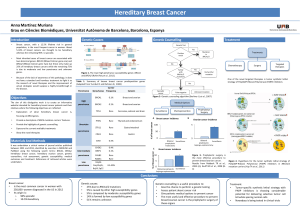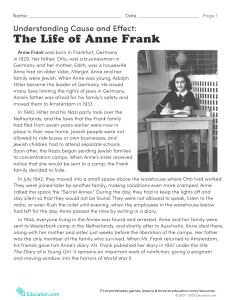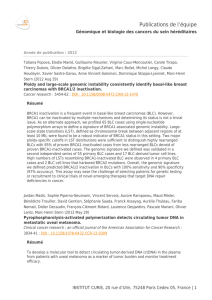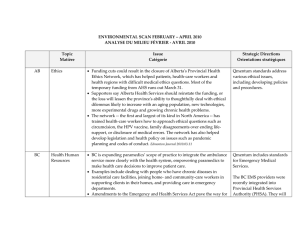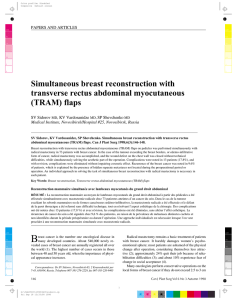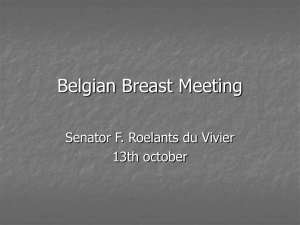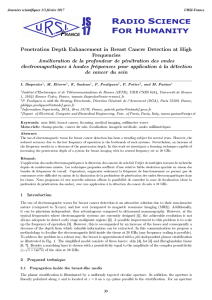Inherited breast cancer
publicité
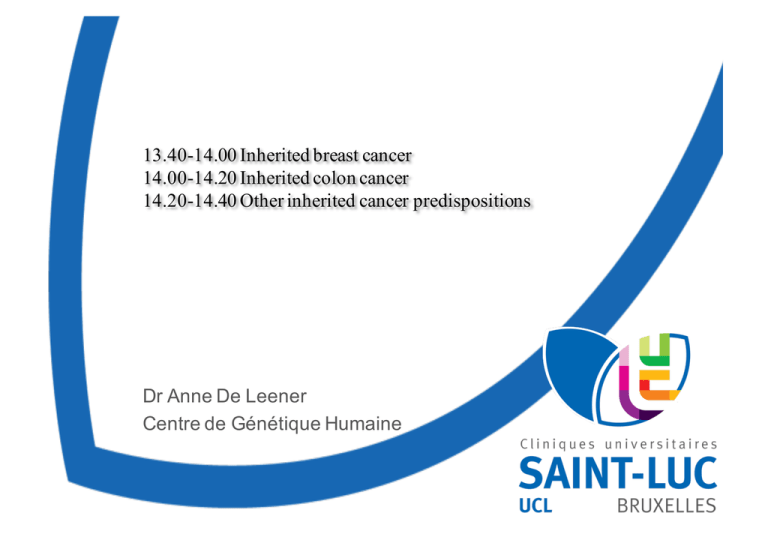
13.40-14.00 Inherited breast cancer 14.00-14.20 Inherited colon cancer 14.20-14.40 Other inherited cancer predispositions Dr Anne De Leener Centre de Génétique Humaine 1. INHERITED BREAST CANCER Introduction Breast cancer : clinicopathological features hormone receptor level (ER and PgR) HER2 histological grade (1 to 3) proliferation index (e.g. Ki67) size (≤ 2cm, 2.1-5cm, >5cm) peritumoral vascular invasion axillary lymph node involvement Ann Oncol. 2009 Aug;;20(8):1319-­29 Cliniques universitaires Saint-­Luc – Anne De Leener 2 Introduction Breast cancer : multidisciplinary team surgeon / gynaecologist medical oncologist radiation oncologist radiologist pathologist geneticist 3 Cliniques universitaires Saint-­Luc – Anne De Leener Breast cancer: risk factors Sex • 1 M / 100 F Age • the risk increases with age • but 15-20% before the age of 50 Family history Personal history Environmental factors (geographic migration) Prolonged exposure to oestrogens: • Early menarche • Late menopause • Late first pregnancy, few pregnancies • Lack of breast-feeding Other breast lesions (in situ carcinoma, atypical hyperplasia, radial scar, ...) Controversies: endocrine treatment for menopausal status, weight, alcohol, tobacco, … 4 Cliniques universitaires Saint-­Luc – Anne De Leener Introduction Familial cases Breast cancer – genetic risk Hereditary syndrome 15% of healthy women have at least one 1st degree relative with breast cancer à risk x 2 Breast cancer risk increases with the number of 1st degree relatives with breast cancer 1: x 1.8 2: x 2.9 3: x 3.9 BRCA1 and BRCA2 germline mutations are responsible for 20-40% of familial breast cancer cases, but < 5% of all breast cancers > 50% of the genetic predisposition to familial breast cancer remains unexplained 5 Cliniques universitaires Saint-­Luc – Anne De Leener Risk of breast cancer predisposition Robson & Offit, NEJM 2007 6 Cliniques universitaires Saint-­Luc – Anne De Leener Familial history: ? Genetic impact Foulkes WD, NEJM 2008 ¨ 7 Cliniques universitaires Saint-­Luc – Anne De Leener Low-­‐risk breast cancer susceptibility genes/alleles BRCA1, BRCA2, TP53, PTEN, STK11 Multiple risk alleles Population frequency <0,1% Relative risk 10–20 fold Disease Risk 20x ATM, BRIP1, CHEK2, PALB2 Multiple risk alleles in each gene Population frequency <0,7% Relative risk 2–4 fold 10x rs2981582 rs3817198 5x (FGFR2), rs3803662 (TNRC9), rs889312 (MAP3K1), (LSP1), rs13281615 (8q), rs13387042 (2q), rs1045485 (CASP8) Population frequency 10-50% Relative risk 1,25-1,65 fold 0,1% 5% Allele frequency 50% 8 Cliniques universitaires Saint-­Luc – Anne De Leener BRCA1 and BRCA2 Genes: Encode proteins that are mainly involved in DNA repair : Loss of function à genomic instability à tumor development BRCA1 : chr 17q21 BRCA1 81 kbp 22 exons BRCA2 84 kbp 26 exons Proteins BRCA2 : chr 13q13 9 Cliniques universitaires Saint-­Luc – Anne De Leener BRCA1 and BRCA2 Exact pathophysiology remains unknown; tumor progression arises from different cellular subtypes : BRCA1 mainly triple negative (ER-, PgR-, HER2-) “basal-like” subtype BRCA2 mainly ER+ “luminal” subtype 10 Cliniques universitaires Saint-­Luc – Anne De Leener BRCA1 and BRCA2 Thousands of different sequence variants have been identified : 1) mutations that are known or likely to be deleterious and diseaseassociated: class 5 or 4 2) variants of unknown function : class 3 = UV : unclassified variants 3) genetic variants that are likely to be neutral and without clinical importance: class 2 or 1 Help for interpretation of the variants: Ø Databases: dbSNP, UMD, Ø Look for conservation of the AA, functional site, etc Ø Align: Grantham variation/grantham deviation: look for the impact of AA changes EMQN Best Practice Guidelines 2007 Ø Splice site prediction (Alamut, etc) 11 Cliniques universitaires Saint-­Luc – Anne De Leener BRCA1 and BRCA2: High penetrance : high risk of disease if mutation is found But risk also depends on: Sex • 1 M / 100 F Age • the risk increases with age • but 15-20% before the age of 50 Personal history Environmental factors (geographic migration) Prolonged exposure to estrogens: • Early menarche • Late menopause • Late first pregnancy, few pregnancies • Lack of breast-feeding Other breast lesions (in situ carcinoma, atypical hyperplasia, radial scar, ...) Controversies: endocrine treatment for menopausal status, weight, alcohol, Cliniques universitaires Saint-­Luc – Anne De Leener tobacco, … 12 BRCA1 and BRCA2 High penetrance : BRCA1 : breast (women) : young age, 82% cumulative risk at age 80 years ovary : 54% cumulative risk at age 80 years colon prostate BRCA2 : breast (women) : cumulative risk same as BRCA1 ovary : lower cumulative risk than BRCA1 (23% at age 80 years) breast (men) : increased risk (10% of breast cancers in males have a BRCA2 mutation) pancreas colon prostate larynx BJMO 2008 – 2(4), pp. 198-­204 Am. J. Hum. Genet. 72:1117–1130, 2003 Cliniques universitaires Saint-­Luc – Anne De Leener 13 Aims of the genetics consultation Provide answers to an individual who is looking for the origin of their personal and family history of cancer Establish whether tumor risk is higher or similar to the risk of the general population Recommend how patients should be taken care of 14 Cliniques universitaires Saint-­Luc – Anne De Leener Br. T, 54 Br. T, 42 Br. T, 45 Br. T, 56 ? Br. T, 36 Br. T, 34 aged 39 Br. T, 40 15 Cliniques universitaires Saint-­Luc – Anne De Leener BRCA1 and BRCA2: who should be tested? BRCA1 and BRCA2 analyses: expensive in terms of manpower and material à define a sub-population in which the mutations are frequent à improvement of the cost / benefit ratio Criteria to take into account : family history (family tree – up to 3rd generation) age at onset triple negative breast cancer male case in the family Ashkenazi Jewish origin other types of cancer in the same patient or in the family Define the risk of having a mutation 16 Cliniques universitaires Saint-­Luc – Anne De Leener Indication of genetic analysis 17 Cliniques universitaires Saint-­Luc – Anne De Leener Indication to perform a genetic analysis (KCE 2015): Ø High risk woman. Ø Risk to find a mutation > 5% Ø BeSHG criterias Woman with breast cancer + one or more of the following : Ø diagnosed ≤ 35 yrs, Ø diagnosed < 50 yrs and one relative with bilateral, or ovarian, or breast < 50, or male breast cancer Ø bilateral breast cancer and both diagnosed < 50 yrs Ø ovarian cancer, any age Ø triple negative breast cancer < 50 yrs Ø three individuals with breast cancer, one is a first degree relative (FDR) of the other two (excluding male transmitters) and one diagnosed < 50 years Ø individual of ethnicity associated with higher frequency of specific mutations (eg, Ashkenazi Jewish): eligible for founder mutation testing Ø other family situations (eg multiple pancreatic cancer) with a priori chance of mutation >10% according to BRCAPRO or Evans criteria or Manchester score Ø test more than one affected relative if criteria remain positive after excluding the negative Ø case as a phenocopy 18 Cliniques universitaires Saint-­Luc – Anne De Leener Ø Woman with high grade serous or papillary epithelial ovarian cancer at any age (excludes borderline, low grade and mucinous ovarian cancer) Ø Male with breast cancer Ø Individual with pancreatic cancer at any age with ≥ 2 FDR excluding male transmitters with breast where one diagnosed <50 or bilateral ,or ovarian, or 2 more pancreatic cancer at any age Family history •First degree unaffected relative of any of the above on a case by case basis •Testing of unaffected family members should only be considered when no affected family member is available and then the unaffected family member with the highest probability of mutation should be tested 19 Cliniques universitaires Saint-­Luc – Anne De Leener BRCA1 and BRCA2: How to interpret the results? Many mutations, different from one family to another A clearly deleterious mutation cannot be identified in all cases à 2-step process : Index case (usually a family member treated for cancer at a young age) then analyze the relatives, if appropriate (usually asymptomatic) If no mutation could be identified after the analysis of the index case, the test should be considered as non informative, because the presence of a deleterious mutation cannot be excluded, and no presymptomatic test can be offered to the relatives If a mutation is identified, a predisposition test can be offered to the relatives : if it is negative, it can be concluded that the relative has not inherited the familial predisposition factor Minors : no indication to test 20 Cliniques universitaires Saint-­Luc – Anne De Leener BRCA1 and BRCA2 Software for risk assessment e.g. BOADICEA http://www.srl.cam.ac.uk/genepi/boadicea/boadicea_intro.html 21 Cliniques universitaires Saint-­Luc – Anne De Leener Br. T, 54 Br. T, 42 Br. T, 45 Br. T, 56 ? Br. T, 36 Br. T, 34 aged 39 Br. T, 40 22 Cliniques universitaires Saint-­Luc – Anne De Leener Br. T, 54 Br. T, 42 Br. T, 45 Br. T, 56 ? Br. T, 36 Br. T, 34 aged 39 Br. T, 40 INDEX CASE 23 Cliniques universitaires Saint-­Luc – Anne De Leener Hypothesis 1 Br. T, 54 Br. T, 42 Br. T, 45 Br. T, 56 ? Br. T, 36 Br. T, 34 aged 39 INDEX CASE: BRCA1 mt Br. T, 40 24 Cliniques universitaires Saint-­Luc – Anne De Leener Hypothesis 1-a Br. T, 54 Br. T, 42 Br. T, 45 Br. T, 56 ? Br. T, 36 Br. T, 34 aged 39 INDEX CASE: BRCA1 mt BRCA1 mt Br. T, 40 25 Cliniques universitaires Saint-­Luc – Anne De Leener Hypothesis 1-b Br. T, 54 Br. T, 42 Br. T, 45 Br. T, 56 ? Br. T, 36 Br. T, 34 aged 39 INDEX CASE: BRCA1 mt BRCA1 wt Br. T, 40 26 Cliniques universitaires Saint-­Luc – Anne De Leener Hypothesis 2 Br. T, 54 Br. T, 42 Br. T, 45 Br. T, 56 ? Br. T, 36 Br. T, 34 aged 39 INDEX CASE: BRCA1 wt Br. T, 40 27 Cliniques universitaires Saint-­Luc – Anne De Leener BRCA1 and BRCA2 Software for risk assessment e.g. BOADICEA http://www.srl.cam.ac.uk/genepi/boadicea/boadicea_intro.html 28 Cliniques universitaires Saint-­Luc – Anne De Leener In case of BRCA1 / BRCA2 mutation Breast cancer screening: From 20 y.o.: ‒ Physical examination every 6 months From 25 y.o. if BRCA1 (or 30 y.o. if BRCA2): ‒ Physical examination every 6 months ‒ MRI 1x/year ‒ Ultrasound (+/- mammogram at 35 – 40y) 1x/year 29 Cliniques universitaires Saint-­Luc – Anne De Leener In case of BRCA1 / BRCA2 mutation Alternative to breast cancer screening Prophylactic mastectomy 30 Cliniques universitaires Saint-­Luc – Anne De Leener In case of BRCA1 / BRCA2 mutation Ovarian cancer prevention No screening technique is effective Preventive removal of the ovaries ‒ never if childbearing wish ‒ not before 35 y.o. ‒ ideally at the latest § at 40 y.o. if BRCA1 § at 50 y.o. if BRCA2 ‒ indication validated by a multidisciplinary team ‒ consultation with the team’s psychologist ‒ clinical and psychological follow-up 31 Cliniques universitaires Saint-­Luc – Anne De Leener The benefics of prophylactic salpyngo-oophorectomy Kauff et al, NEJM 2002 Cliniques universitaires Saint-­Luc – Anne De Leener 32 Treatment of breast cancer in case of BRCA1 or BRCA2 mutation Adjuvant treatment: Same as if no mutation Often younger age of onset and thus more chemotherapy Endocrine therapy if ER+ Herceptin if HER2+ Metastatic treatment: Same as if no mutation Sensitivity to platins The future: PARP inhibitors? 33 Cliniques universitaires Saint-­Luc – Anne De Leener Conclusion I: Refer to genetic counseling KCE 2012 Cliniques universitaires Saint-­Luc – Anne De Leener 34 2. Other inherited cancer predisposition (breast cancer risk) TP53 Li-Fraumeni syndrome : prevalence : 1-9/100,000 due to TP53 germline mutation association : breast cancer Sarcoma: osteosarcoma, soft tissue sarcoma, Adrenocortical carcinoma leukemia brain tumor Others (lung, colon, genitourinary, skin, prostate etc) occurrence at a young age, multiple cancers Incomplete penetrance has been described Avoid radiation Accumulation of defective protein in the cell: Loss of transcriptional activity Eur J Hum Genet. 2009 Jun;;17(6):722-­31 Cliniques universitaires Saint-­Luc – Anne De Leener 35 Li-Fraumeni syndrome: heterozygous TP53 mutation Brain T, 35 Sarcoma, 39 28 y.o. Br. T, 38 Br. T, 39 Sarcoma, 15 Br T, 41 Lung T, 44 21 y.o. Brain T, 6 Brain T, 9 36 Cliniques universitaires Saint-­Luc – Anne De Leener 37 Cliniques universitaires Saint-­Luc – Anne De Leener Rare syndromes Peutz – Jeghers syndrome : frequency : 1-9/100,000 heterozygous germline mutations of STK11 (tumor suppressor gene) association : gastro-intestinal polyps (hamartomas) IG (jéjunum proximal) > Colon > Rectum > Estomac abnormal pigmentation of the skin and mucosa increased risk of various cancers ‒ including breast cancer (ductal carcinoma) : § 45% risk at age 70 years ‒ Gynecologic cancer ‒ Ovarian cancer § Sex cord tumors with annular tubules (SCTAT) Eur J Hum Genet. 2009 Jun;;17(6):722-­31 Cliniques universitaires Saint-­Luc – Anne De Leener 38 39 Cliniques universitaires Saint-­Luc – Anne De Leener Rare syndromes Cowden syndrome frequency : 1-9/1,000,000 germline mutations of PTEN (tumor suppressor gene) association : Macrocephaly multiple hamartomas (skin, breast, thyroid, gastro-intestinal tract, endometrium, brain) increased risk of various cancers: ‒ including breast cancer : 30-50% at age 70 years ‒ Thyroid: carcinoma trichilemmome Eur J Hum Genet. 2009 Jun;;17(6):722-­31 40 Cliniques universitaires Saint-­Luc – Anne De Leener 41 Cliniques universitaires Saint-­Luc – Anne De Leener 42 Cliniques universitaires Saint-­Luc – Anne De Leener Rare syndromes CDH1 mutations (tumor suppressor gene) : Epithelial cadherin Somatic alteration: loss of E-Cadherin expression association : diffuse gastric cancer lobular breast cancer (risk 60% at 80y), bilateral Fitzgerald, R. C., R. Hardwick, et al. (2010). "Hereditary diffuse gastric cancer: updated consensus guidelines for clinical management and directions for future research." J Med Genet 47(7): 436-­444. Cliniques universitaires Saint-­Luc – Anne De Leener Eur J Hum Genet. 2009 Jun;;17(6):722-­31 43 Rare syndromes Type 1 neurofibromatosis : von Recklinghausen disease frequency : 1-5/10,000 autosomal dominant transmission NF1 germline mutations (tumor suppressor gene) association : cafe au lait spots neurofibromas lentigines Lisch nodules (=hamartomas of the iris) bone problems increased risk of breast cancer ‒ standardized incidence ratio : 3.5 Eur J Hum Genet. 2009 Jun;;17(6):722-­31 44 Cliniques universitaires Saint-­Luc – Anne De Leener Conclusions II Breast cancer is frequent Genetic predisposition is only partially explained by BRCA1/2 mutations +/- 10% of breast cancers are due to a genetic predisposition < 5% are due to BRCA1 or BRCA2 germline mutations BRCA1 and BRCA2 mutations are rare in the general population (<1/800) ‒ But they have a high penetrance Multiple different mutations exist Only patients with a real probability of mutation should be tested Other, rare genetic anomalies exist Future breast cancer treatments will take into account constitutional and somatic GENETIC alterations 45 Cliniques universitaires Saint-­Luc – Anne De Leener
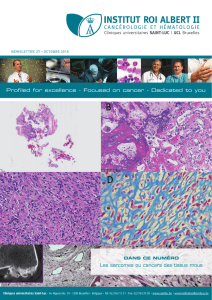
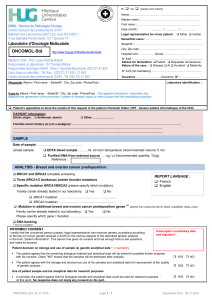
![Poster LIBER san antonio 2011 [Mode de compatibilité]](http://s1.studylibfr.com/store/data/000441925_1-0f624c1012097e18f69fca01a2951eb6-300x300.png)

